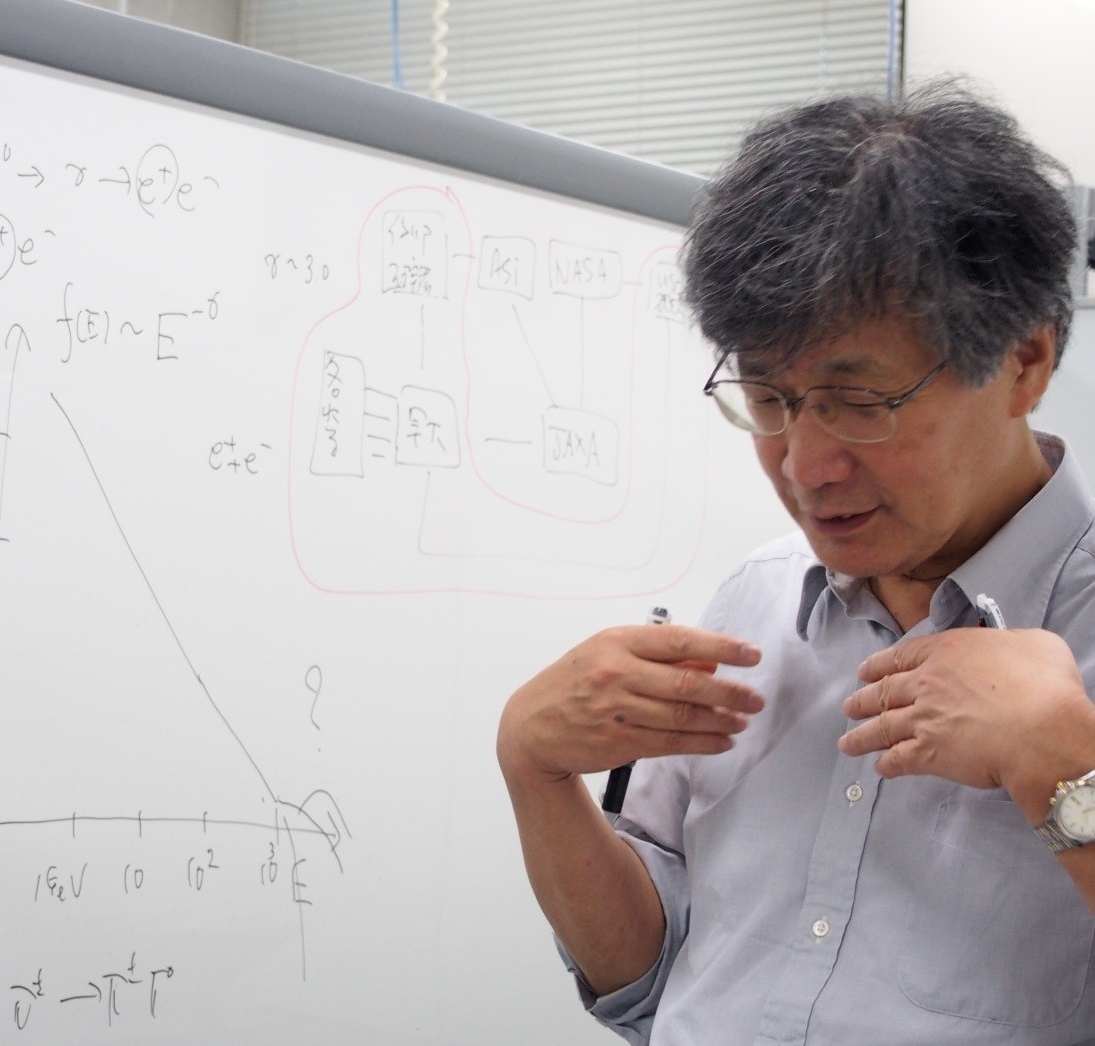Waseda Frontline Research Vol. 5, Part 2 – A new challenge to solve the mysteries of the universe
Tue, Oct 27, 2015-
Tags
Physicist and cosmic rays specialist Professor Shoji Torii
Waseda Research Institute for Science and Engineering
Director of WASEDA Institute for Space Science Observation System
Representative of CALET Project
Closing in on the true nature of dark matter
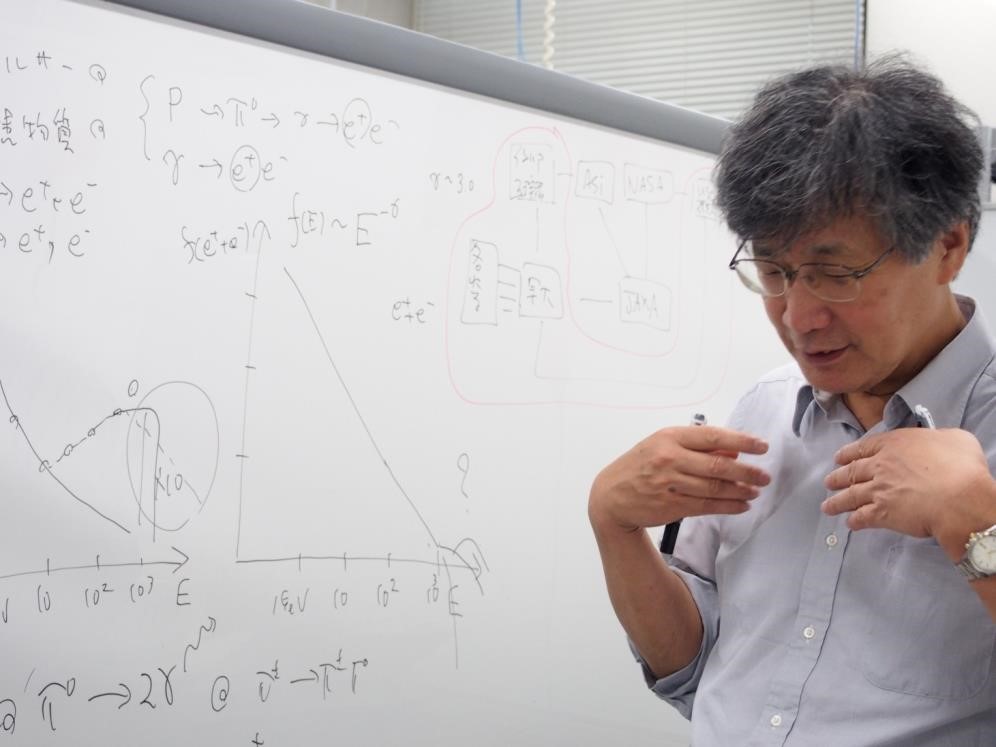
In August 2015, the Tanegashima Space Center launched the H-II Transfer Vehicle Kounotori 5. Kounotori is a spacecraft constructed to deliver necessary commodities such as water, food, and clothing as well as various devices and equipment to astronauts on the International Space Station (ISS). One of these devices is an experimental unit that is garnering worldwide attention. It is called the “CALorimetric Electron Telescope (CALET).” As CALET has launched into space and will soon begin conducting experiments, we took this opportunity to speak with Professor Shoji Torii from Waseda’s Research Institute for Science and Engineering to shed light on the CALET and its great potential.
(Interview Date: September 10, 2015)
Unprecedented high-performance “calorimeter”
CALET’s primary detection equipment is a “calorimeter” that captures and observes cosmic rays coming toward it.
As shown in the figure below, the calorimeter consists of three layers.
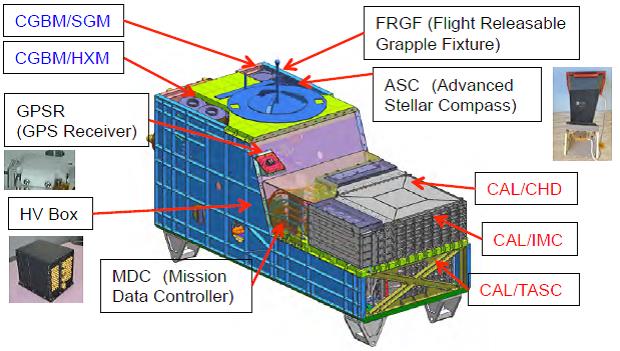
CALET System Overview [1] (Source: Shoji Torii, et al: CALET team “CALorimetric Electron Telescope (CALET) Whole Report,” Japan Physical Society’s 70th annual conference in March 2015)
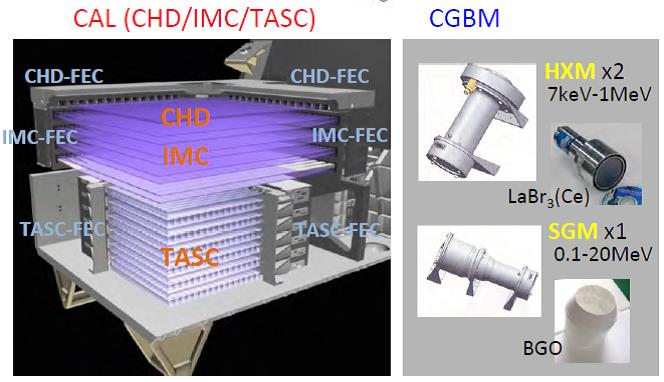
CALET System Overview [2] (Source: Shoji Torii, et al: CALET team “CALorimetric Electron Telescope(CALET) Whole Report” Japan Physical Society’s 70th annual conference in March 2015)
The first layer (CHD), as seen in the figure above, measures the electrical charge of particles as a means to identify the atomic number. The second layer (IMC) identifies the direction of flying particles. The third and thickest layer (TASC) identifies the energies and types of cosmic rays in reference to the growth of the “shower” generated by absorbed cosmic rays.
We can learn much of what we need to know about cosmic rays by integrating the information obtained from these three layers. The observable energy level of particles is determined by the thickness of the third layer and its materials. CALET boasts higher performance in this aspect compared to conventional observation equipment.
One of CALET’s important features is its use of the ISS’s extravehicular experimental platform. This has significant advantages. When flying observation equipment as a single artificial satellite, it is necessary to install systems such as electric power, attitude control devices, operation control devices, and communication devices in the satellite. CALET, however, can use the ISS’s system and therefore only requires the observation equipment. This is significantly advantageous in terms of system efficiency and development costs and time, making CALET a sophisticated piece of equipment.

Relocation from the exposed palette of the CALorimetric Electron Telescope (CALET) to the extravehicular experimental platform (Source: (C) Japan Aerospace Exploration Agency (JAXA))
* CALET is in the right of the center.
CALET will be in operation for two to five years, and it is expected to yield a variety of results. The major two results are as follows.
Expected Result 1 – Specifying a celestial body that serves as an accelerated source of electrons
The most widely believed explanation about where high-energy cosmic rays come from and how they accelerate (i.e., how they came to be high energy) is from a supernova explosion. A supernova explosion occurs when a massive supergiant star ceases to exist and releases tremendous energy. It appears that the particles accelerated by such energy and blown to Earth are high-energy cosmic rays. However, we do not yet know about the details of this acceleration mechanism.
Understanding this mechanism requires incredibly precise observation of higher-energy cosmic rays. Observing high-energy cosmic rays in the TeV (Tera electron Volt) range with a low rate of error used to be difficult. However, thanks to the third layer of CALET’S calorimeter and its high performance compared to conventional observation equipment, CALET can accomplish this because it uses a “total absorption type” with a thick layer and the ability to perform more precise observation than the conventional “sampling type.” The implementation of this total absorption type equipment has made it possible to identify the types of cosmic rays (or particles) more accurately.
One of the most important cosmic rays to be observed is the electron. It is understood that electrons with energy exceeding 1 TeV can reach the Earth only due to acceleration caused by a relatively recent supernova explosion that occurred near the solar system. Because there are only three such celestial bodies, successfully observing such high-energy electrons with high precision will allow us to directly identify the celestial body that serves as the acceleration source. If this is made possible, it will be the first case in the world of direct observation of cosmic rays. This is CALET’s primary objective.
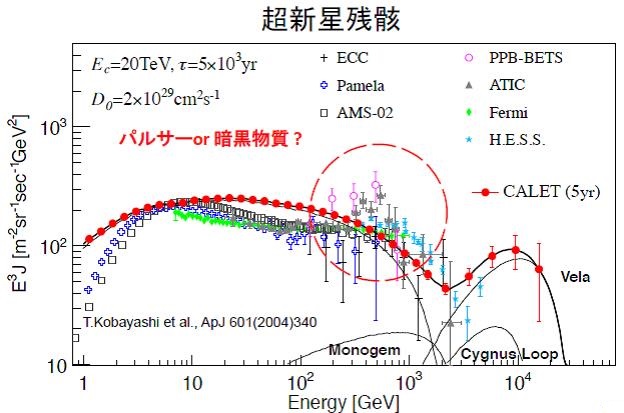
A calculated electron flux at the TeV region from nearby SNR and a predicted observation by CALET. The present observations below 1 TeV present an excess of the electron flux around several 100 GeV, which might be caused by contribution from pulsars or dark matter.
Expected result 2 – Getting closer to the true nature of dark matter
Another general mystery of the universe is the existence of “dark matter”. With the accumulated observations of mankind, we have been able to observe only about 5% of the total matter that makes up space. The remaining 95% of matter cannot be seen because it does not emit light, even though the structure and origin of the universe cannot be explained without it. Of this, 24% is dark matter (and the remaining 71% is dark energy, which is a probable cause of cosmic expansion).
The true nature of dark matter remains unknown, but it appears to be made up of weakly interacting, massive, and undiscovered particles known as “WIMPs” (Weakly Interacting Massive Particle). It seems collisions between two WIMPs cause phenomena such as pair annihilation or collapses which converts most of the mass into energy, thereby generating high-energy elementary particles. CALET’s successful observations of such elementary particles will provide strong evidence to support the existence of WIMPs and may unlock the secrets of dark matter.
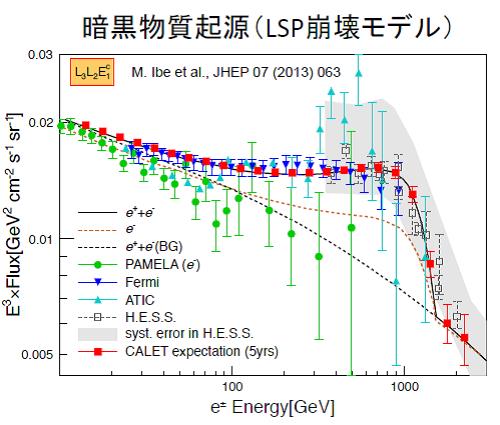
An expected electron(+positron) flux by decay of a kind of dark matter, Wino with a mass of 3 TeV, which is consistent with the present observations below 1TeV and a prediction by the CALET observation.
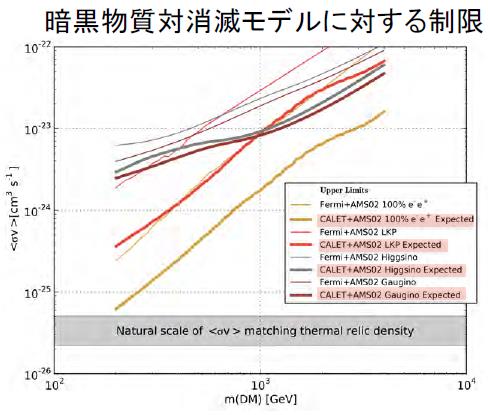
Energy dependence of upper limit of a dark matter annihilation parameter (cross section x velocity) for the CALET observation, assuming a single pulsar contribution for the excess of positrons and electrons. The different modes of the annihilation are presented in comparison with the present observations.
In the final part of this volume, we speak more with Professor Torii, the representative of the CALET project.
Profile
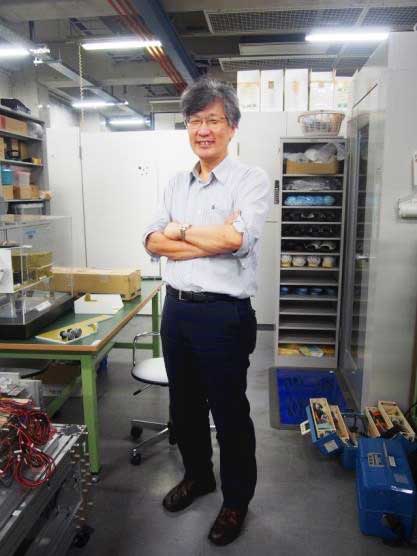
Professor Shoji Torii graduated from Kyoto University’s Faculty of Science in 1972. He completed the doctoral program at Kyoto University’s Graduate School of Science without a degree in 1997 and obtained a Doctorate of Science at Kyoto University in 1978. Torii became an incentive researcher at the Japan Society for the Promotion of Science (Institute for Cosmic Ray Research, the University of Tokyo) in 1977, a researcher at Tokyo University’s Institute for Cosmic Ray Research in 1979, and a research associate at Utah State University’s Faculty of Physics. Torii became an assistant, instructor, Associate Professor and Professor at Kanagawa University’s Faculty of Engineering in 1983. He became a Professor of Waseda University’s School of Science and Engineering in 2004. He currently serves as Professor at the Waseda Research Institute for Science and Engineering, Director of WASEDA Institute for Space Science Observation System, and representative of the CALET project. He is an expert on the physics of cosmic rays and was Commissioner of the Japan Physical Society (61st and 62nd periods).
Website/Video Site
Torii Laboratory, Waseda University Research Institute for Science and Engineering
CALET – CALorimetric Electron Telescope website
Video of CALET upon space station Kibo
Recent News
Japanese space research and development on International Space Station
Recent Research
- Observing Cosmic Rays in Space(The Centenary of the Discovery of Cosmic Rays)
- “Calet Mission for Exploring the High Energy Universie” – IEEJ Transactions on Fundamentals and Materials Vol.132 pp.603-608. (2012)
- An Excess of Cosmic Ray Positrons and Electrons May Confirm Dark Matter?
- For more, please refer to the following link: http://www.crlab.wise.sci.waseda.ac.jp/


